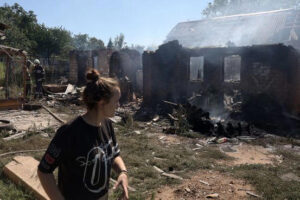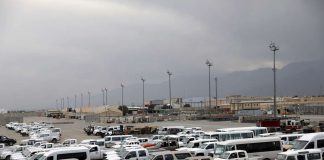AUGUST 25, 2022

ODESSA, UKRAINE — The death toll from Wednesday’s Russian missile strikes in eastern Ukraine rose to 25 as Moscow claimed it had foiled a new terror plot by a Kyiv supporter at home.
Ukrainian rescue operations continued in the town of Chaplyne a day after missiles struck a train station and a residential area in the deadliest Russian attack on civilians in the country in more than a month. At least two children are among the dead, according to Ukrainian officials. More than 30 people were injured.
The missile strikes took place as Ukraine celebrated its Independence Day, marking 31 years since the country declared independence from the crumbling Soviet Union. Kyiv had warned Russia might scale up its attacks on civilian targets around that date.
“There are no such bombs that can erase freedom, and there will never be such missiles that can break the will of the people who believe in themselves,” Ukrainian President Volodymyr Zelensky said in a video posted online late Wednesday night. “Chaplyne is our pain today.”
Russian shells also hit other parts of the Dnipropetrovsk region, where Chaplyne is located, according to the governor. Several buildings were destroyed in Velykomykhailivka, injuring eight people. In western Ukraine, three people were injured in a rocket attack on the city of Khmelnytskyi.
Russia’s defense ministry said on Thursday that the strike at the train station destroyed “200 Ukrainian reserve servicemen and 10 units of military equipment.” The ministry said the attack on Khmelnytskyi targeted a weapons repair station.
In addition, Russian authorities said they had prevented a terrorist attack in Kaliningrad, Russia’s exclave on the Baltic Sea, the state news agency TASS reported Thursday.
A Russian citizen was detained on suspicion of planning attacks on installations of Russia’s Baltic Fleet, which is stationed there, as well as the region’s Khrabrovo international airport, TASS said.
Investigators said they found five kilograms of TNT explosive in the suspect’s home as well as propaganda and symbols of the Ukrainian Azov military unit, which Russia considers a terrorist organization.
A video released by Russia’s FSB intelligence agency via RIA, another state news agency, showed a heavily armed commando unit breaking into a camping trailer and arresting the man, who was sleeping inside at the time. The suspect is then seen confessing to his alleged terror plot.
The news comes after a string of attacks on Russian military installations far beyond the front line, in occupied Crimea and mainland Russia.
On Saturday, a well-known Russian nationalist agitator, Darya Dugina, was killed in an apparent car bombing near Moscow. Ms. Dugina was the daughter of Alexander Dugin, a neo-fascist philosopher and activist who has advocated genocide of Ukrainians.
The incidents could have been staged or exploited by Russian officials to generate panic and prime the population for future moves related to the Ukraine invasion, said John Lough, associate fellow with Chatham House, a British think tank.
“Logically, it would seem they would stage these sort of events to justify some action against Ukraine and at the same time to prepare the population for whatever that might be,” Mr. Lough said.
“There is a sinister feel to all this,” he added. “It feels that the Russian side is in a lot of difficulty right now because their campaign is going very badly.”
Russia also detained two employees of the Zaporizhzhia nuclear power plant in southern Ukraine, Europe’s largest, who they accused of aiding the Ukrainian military, according to the press service of the Russian national guard.
Russian troops seized the power station at the start of March, and this month began to move heavy weaponry onto the grounds of the plant. On Thursday, the British Ministry of Defense released images of the power plant, which it said showed armored vehicles within 60 meters of one of the reactors.
“Russia is probably prepared to exploit any Ukrainian military activity near ZNPP for propaganda purposes,” the British ministry said, using an acronym for the plant. “While Russia maintains the military occupation of ZNPP, the principal risks to reactor operations are likely to remain disruption to the reactors’ cooling systems, damage to its back-up power supply, or errors by workers operating under pressure.”
Dmitry Orlov, the exiled mayor of Enerhodar, where the power plant is located, wrote that the facility was again the site of explosions on Thursday, as it has been on and off for weeks.
“Today, as a result of enemy shelling, the city was left completely without electricity and water,” he wrote on Telegram. “Now we are finding out how critical the situation is.”
Russia has accused Ukrainian forces of shelling the plant from across a nearby reservoir, which Ukraine has denied. Russian officials said the outage Thursday, which also affected Kherson and Melitopol, was caused by a brush fire in fields near the plant and that power was quickly restored.
Elsewhere, Ukrainian officials said they struck the Kakhovsky bridge, further damaging Moscow’s supply lines in the southern Kherson region, where they are trying to isolate Russian troops west of the Dnipro River. Ukrainian troops also fired again at the Antonovsky bridge near Kherson city, regional authorities told Russian state media.










































































































